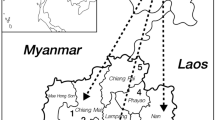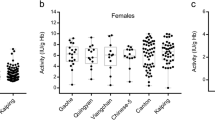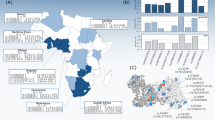Abstract
Glucose-6-phosphate dehydrogenase (G6PD) deficiency protects from severe forms of malaria. It is interesting therefore to analyze the molecular basis underlying G6PD deficiency in regions such as the Mediterranean basin where malaria was present for a long time in history. Here we report on the genetic characterization of G6PD deficiency among inhabitants of one Mediterranean region—the Dalmatian region of south Croatia. We analyzed 24 unrelated G6PD-deficient male subjects. Molecular testing revealed several different mutations: G6PD Cosenza 9, G6PD Mediterranean 4, G6PD Seattle 3, G6PD Union 3, and G6PD Cassano 1. Furthermore, we have identified one novel G6PD variant that we named G6PD Split. This variant is caused by a nucleotide change 1442 C→G leading to the amino acid substitution 481 Pro→Arg and is characterized by moderate enzyme deficiency (class III variant). This study reveals a higher prevalence (37.5%) of the Cosenza mutation in the Dalmatian region than anywhere else previously investigated and overall shows the considerable molecular heterogeneity underlining G6PD deficiency that can be observed in Mediterranean populations.
Similar content being viewed by others
Introduction
Glucose-6-phosphate dehydrogenase (G6PD) is an X-linked enzyme that is present in all cells and is involved in the detoxification of oxidizing agents. G6PD deficiency is linked to diverse clinical phenotypes, including neonatal jaundice, drug-induced hemolysis, favism, and chronic nonspherocytic hemolytic anemia (Vulliamy et al. 1992; Beutler 1994). It is estimated that approximately 400 million people around the world are affected with G6PD deficiency. The majority of deficient individuals live in tropical and subtropical regions in which malaria is endemic or where malaria has been eradicated only recently. This distribution of G6PD deficiency as well as functional analysis of deficient erythrocytes and epidemiological data has indicated that G6PD deficiency has a protective role against malaria (Luzzatto et al. 1969; Ruwende et al. 1995; Mehta et al. 2000). Thus, studying the molecular basis of G6PD deficiency in malaria-affected parts of the world is of special interest. Until now, over 140 different mutations of the G6PD gene have been identified (Beutler and Vulliamy 2002). Most of these are single missense mutations; no large deletions or frameshift mutations have been described, probably because such mutations are incompatible with life (Mehta et al. 2000).
The Dalmatian region of south Croatia is a part of the Mediterranean basin once known to have endemic malaria. Prevalence of G6PD deficiency among high school students of this region is 0.44%, which is lower than in other Mediterranean populations, such as Sardinia, Malta, or Greece (Krželj et al. 2001). Previous molecular analysis identified only the G6PD Mediterranean variant among G6PD-deficient individuals (Terzić et al. 1998) while no other molecular variants were characterized in this region. Since molecular characterization underlining G6PD deficiency in inhabitants of the Croatian Adriatic coast were greatly insufficient, we conducted a more comprehensive genetic analysis of 24 unrelated male subjects with G6PD deficiency.
Materials and methods
Genetic analysis was performed on 24 unrelated individuals with low G6PD activity. Individuals with low enzyme activity were collected from the clinical records of Clinical Hospital Split, having being hospitalized with favism (15 cases) or were collected during the screening of high school students for G6PD deficiency (9 cases) as a part of a study intended to determine incidence of G6PD deficiency in Southern Croatia (Krželj et al. 2001). All individuals included in the study were inhabitants of the Dalmatian region of south Croatia.
G6PD activity was determined by a spectrophotometric method using a commercially available kit (Randox Laboratories, UK). DNA was isolated from peripheral blood using standard phenol/chloroform extraction procedures. The entire coding region of the G6PD gene was amplified by PCR in nine fragments (exons 2, 3+4, 5, 6+7, 8, 9, 10, 11+12, 12+13) and analyzed by SSCP as described previously (Calabro et al. 1993). In order to determine the genetic change in samples that showed a shifted migration on SSCP gels, the relevant exon was reamplified and sequenced (Microsynth AG, Switzerland). Having identified mutations by DNA sequencing, other samples were tested for the presence of the respective mutations by restriction enzyme digestion. The study was approved by the Ethical Committee of the Clinical Hospital Split.
Results and discussion
Among our study subjects we found five different mutations (Table 1): nine cases of G6PD Cosenza (37.5%), four of G6PD Mediterranean (16.6%), three of G6PD Seattle (12.5%), three of G6PD Union (12.5%), one of G6PD Cassano (4.2%), and one novel mutation. Three samples (12.5%) remained uncharacterized. These uncharacterized samples were screened several times by SSCP using different experimental conditions, but we found no indication as to where the mutation lies. They had enzyme activities of 7%, 20%, and 20%, respectively, and they did not have favism.
The G6PD Cosenza mutation, which is the most prevalent in our study sample, was initially described in a neighboring region of Calabria, southern Italy, and is caused by a 1376 G→C nucleotide change leading to a 459 Arg→Pro amino acid substitution (Calabro et al. 1993). This mutation belongs to the group of severe G6PD deficiencies (enzyme activity less then 10%) often associated with hemolysis. Of the nine subjects we identified with this mutation, seven had favism—acute hemolysis following the ingestion of fava beans—while nobody have had chronic hemolysis. Thus far, G6PD Cosenza has been described in different parts of Italy (Calabro et al. 1993; Cappellini et al. 1996; Alfinito et al. 1997; Martinez di Montemuros et al. 1997) and in Iran (Mesbah-Namin et al. 2002), but its prevalence was rather low at around 2% and 7% of the deficient subjects, respectively. Here we report higher prevalence (37.5%) of G6PD Cosenza than anywhere else. We do not know whether this distribution of the Cosenza variant is due to a common ancestry or an independent origin in the Mediterranean basin and Middle East. This could be resolved by studying additional markers in the G6PD gene.
Another three variants of G6PD associated with severe forms of G6PD deficiency were identified in this survey: G6PD Mediterranean (563 C→T), G6PD Union (1369 C→T), and G6PD Cassano (1347 G→C). All patients with those mutations had favism and very low enzyme activity. The G6PD Mediterranean variant was initially described around the Mediterranean Sea but has since been described in different ethnic groups around world (Vulliamy et al. 1988). It is interesting to emphasize that all individuals from our study with G6PD Mediterranean mutation had concomitant silent C→T transition at the position 1311, which is often found in Europe but not in Asia (Terzić et al. 1998). This could suggest an independent origin of G6PD Mediterranean mutation in Europe and Asia, or it could represent crossover or population admixture (Beutler and Kuhl 1990). G6PD Union has been described worldwide while G6PD Cassano was found in neighboring Italy and Greece (Rovira et al. 1994; Menounos et al. 2000). Our findings fit into the scheme of world distribution of these mutations. The only mutation with a moderate enzyme activity found in our population was G6PD Seattle, which is described worldwide (Rodrigues et al. 2002; Vaca et al. 2002).
We have identified a novel nucleotide substitution at the position 1442 C→G leading to amino acid change 481 Pro→Arg, located in the βO sheet (Naylor et al. 1996). This is a substitution of an uncharged amino acid proline to charged arginine just in front of a fully conserved tyrosine residue. According to the G6PD structural data, proline at the position 481 is not involved in enzyme subunit dimerization or NADP+ binding and does not create substrate binding site (Au et al. 2000; Kotaka et al. 2005). This suggests that the described amino acid change has less important functional consequences, which are in parallel with detected enzyme activity of 30% (class III variant). We named this variant G6PD Split.
In conclusion, our study has identified one novel variant, G6PD Split, and highlights the molecular heterogeneity of G6PD deficiency in the Dalmatian region of south Croatia. The situation is rather unusual for countries in this region of the Mediterranean basin in that G6PD Cosenza rather than G6PD Mediterranean is the predominant variant.
References
Alfinito F, Cimmino A, Ferraro F, Cubellis MV, Vitagliano L, Francese M, Zagari A, Rotoli B, Filosa S, Martini G (1997) Molecular characterization of G6PD deficiency in Southern Italy: heterogeneity, correlation genotype-phenotype and description of a new variant (G6PD Neapolis). Br J Haematol 98:41–46
Au SWN, Gover S, Lam VMS, Adams MJ (2000) Human glucose-6-phosphate dehydrogenase: the crystal structure reveals a structural NADP+ molecule and provides insights into enzyme deficiency. Structure 8:293–303
Beutler E (1994) G6PD deficiency. Blood 84:3613–3636
Beutler E, Kuhl W (1990) The NT 1311 polymorphism of G6PD: G6PD Mediterranean mutation may have originated independently in Europe and Asia. Am J Hum Genet 47:1008–1012
Beutler E, Vulliamy T (2002) Hematologically important mutations: Glucose-6-phosphate dehydrogenase. Blood Cells Mol Dis 28:93–103
Calabro V, Mason PJ, Filosa S, Civitelli D, Cittadella R, Tagarelli A, Martini G, Brancati C, Luzzatto L (1993) Genetic heterogeneity of glucose-6-phosphate dehydrogenase deficiency revealed by single-strand conformation and sequence analysis. Am J Hum Genet 52:527–536
Cappellini MD, Martinez di Montemuros F, De Bellis G, Debernardi S, Dotti C, Fiorelli G (1996) Multiple G6PD mutations are associated with a clinical and biochemical phenotype similar to that of G6PD Mediterranean. Blood 87:3953–3958
Kotaka M, Gover S, Vandeputte-Rutten L, Au SWN, Lam VMS, Adams MJ (2005) Structural studies of glucose-6-phosphate and NADP+ binding to human glucose-6-phosphate dehydrogenase. Acta Crystallogr D Biol Crystallogr 61:495–504
Krželj V, Zlodre S, Terzić J, Meštrović M, Jakšić J, Pavlov N (2001) Prevalence of G-6-PD deficiency in the Croatian Adriatic coast population. Arch Med Res 32:454–457
Luzzatto L, Usanga EA, Reddy S (1969) Glucose 6-phosphate dehydrogenase deficient red cells resistance to infection by malarial parasites. Science 164:839–842
Martinez di Montemuros F, Dotti C, Tavazzi D, Fiorelli G, Cappellini MD (1997) Molecular heterogeneity of glucose-6-phosphate dehydrogenase (G6PD) variants in Italy. Haematologica 82:440–445
Mehta A, Mason PJ, Vulliamy TJ (2000) Glucose-6-phosphate dehydrogenase deficiency. Baillieres Best Pract Res Clin Haematol 13:21–38
Menounos P, Zervas C, Garinnis G, Doukas C, Kolokithopoulos D, Tegos C, Patrinos GP (2000) Molecular heterogeneity of the glucose-6-phosphate dehydrogenase deficiency in the Hellenic population. Hum Hered 50:237–241
Mesbah-Namin SA, Sanati MH, Mowjoodi A, Mason PJ, Vulliamy TJ, Noori-Daloii MR (2002) Three major glucose-6-phosphate dehydrogenase deficient polymorphic variants identified in Mazandaran state of Iran. Br J Haematol 117:763–764
Naylor CE, Rowland P, Basak AK, Gover S, Mason PJ, Bautista JM, Vulliamy TJ, Luzzatto L, Adams MJ (1996) Glucose 6-phosphate dehydrogenase mutations causing enzyme deficiency in a model of the tertiary structure of the human enzyme. Blood 87:2974–2982
Rodrigues Mo, Freire AP, Martinis G, Pereira J, Martinis MD, Monteiro C (2002) Glucose-6-phosphate dehydrogenase deficiency in Portugal: biochemical and mutational profiles, heterogeneity, and haplotype association. Blood Cells Mol Dis 28:249–259
Rovira A, Vulliamy TJ, Pujades A, Luzzatto L, Corrons JL (1994) The glucose-6-phosphate dehydrogenase (G6PD) deficient variant G6PD Union (454 Arg→Cys) has a worldwide distribution possibly due to recurrent mutation. Hum Mol Genet 3:833–835
Ruwende C, Khoo SC, Snow RW, Yates SN, Kwiatkowski D, Gupta S, Warn P, Allsopp CE, Gilbert SC, Peschu N, Newbold CI, Greenwood BM, Marsh K, Hill AVS (1995) Natural selection of hemi- and heterozygotes for G6PD deficiency in Africa by resistance to severe malaria. Nature 376:246–249
Terzić J, Krželj V, Drmić I, Anđelinović Š, Primorac D, Meštrović J, Balarin L (1998) Genetics analysis of the Glucose-6-phosphate dehydrogenase deficiency in a South Croatia. Coll Antropol 22:485–489
Vaca G, Arambula E, Esparza A (2002) Molecular heterogeneity of glucose-6-phosphate dehydrogenase deficiency in Mexico: overall results of a 7-year project. Blood Cells Mol Dis 28:436–444
Vulliamy TJ, D’Urso M, Battistuzzi G, Estrada M, Foulkes NS, Martini G, Calabro V, Poggi V, Giordano R, Town M, Luzzatto L, Perscio MG (1988) Diverse point mutations in the human glucose-6-phosphate dehydrogenase gene cause enzyme deficiency and mild or severe hemolytic anemia. Proc Natl Acad Sci USA 85:5171–5175
Vulliamy T, Mason P, Luzzato L (1992) The molecular basis of glucose-6-phosphate dehydrogenase deficiency. Trends Genet 8:138–143
Acknoweledgement
This work was supported by the Croatian Ministry of Science and Technology Grants nos. 0216009 and 0216010.
Author information
Authors and Affiliations
Corresponding author
Additional information
Marin Barišić, Jelena Korać, Ivana Pavlinac, and Vjekoslav Krželj contributed equally to this work
Rights and permissions
About this article
Cite this article
Barišić, M., Korać, J., Pavlinac, I. et al. Characterization of G6PD deficiency in southern Croatia: description of a new variant, G6PD Split. J Hum Genet 50, 547–549 (2005). https://doi.org/10.1007/s10038-005-0292-2
Received:
Accepted:
Published:
Issue Date:
DOI: https://doi.org/10.1007/s10038-005-0292-2
Keywords
This article is cited by
-
3′-UTR variations and G6PD deficiency
Journal of Human Genetics (2013)
-
Prevalence and distribution of glucose-6-phosphate dehydrogenase (G6PD) variants in Thai and Burmese populations in malaria endemic areas of Thailand
Malaria Journal (2011)



